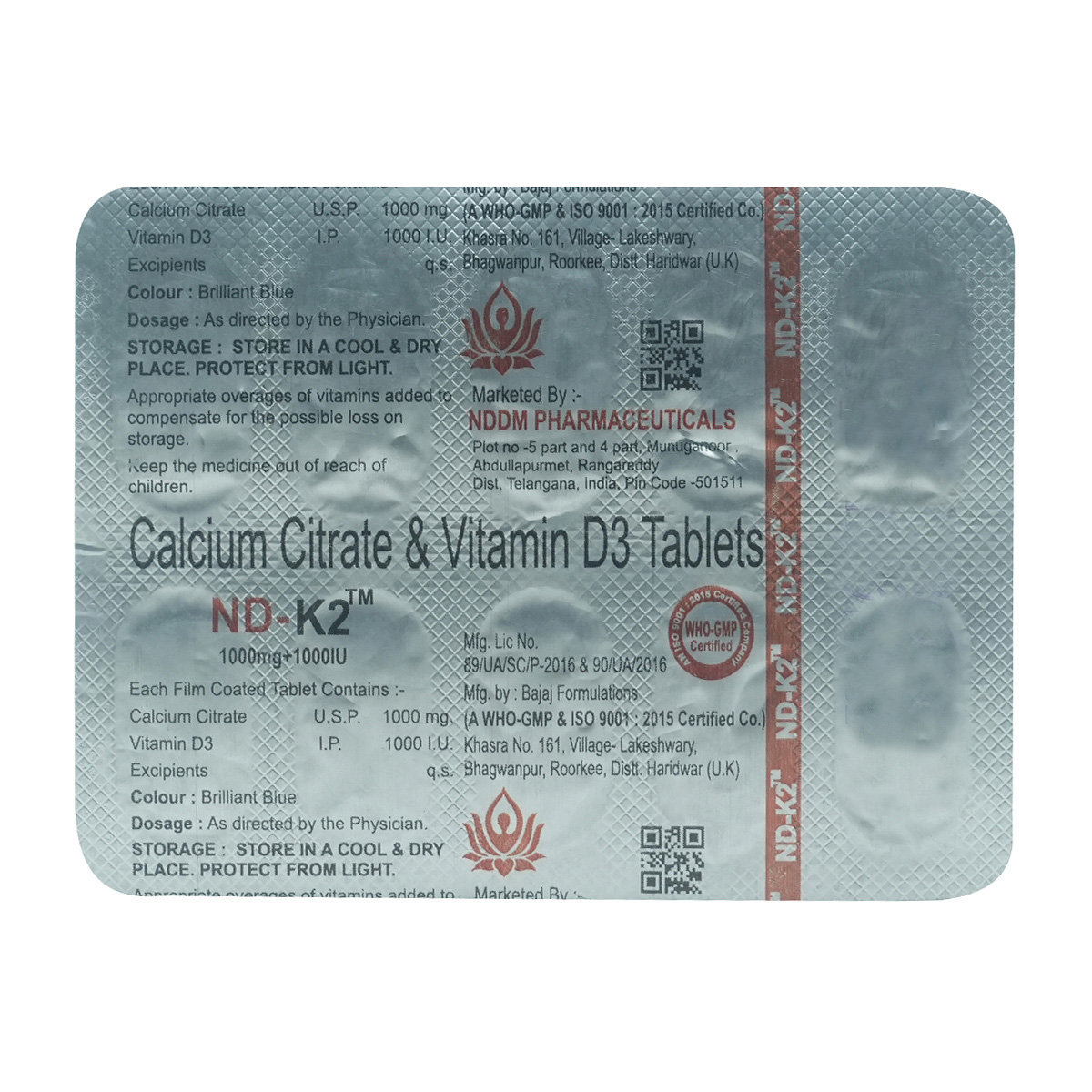D Calford Tablet 10's
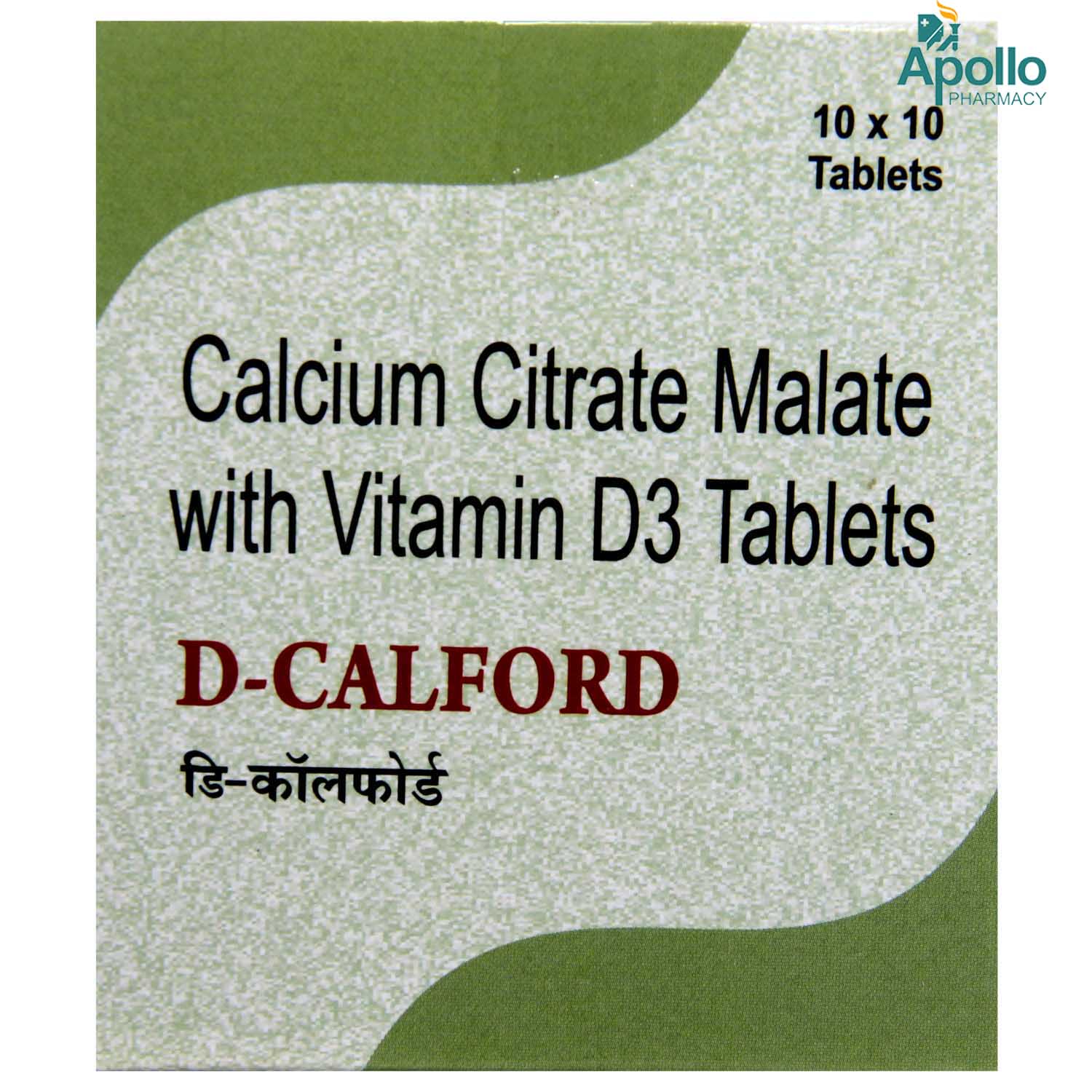
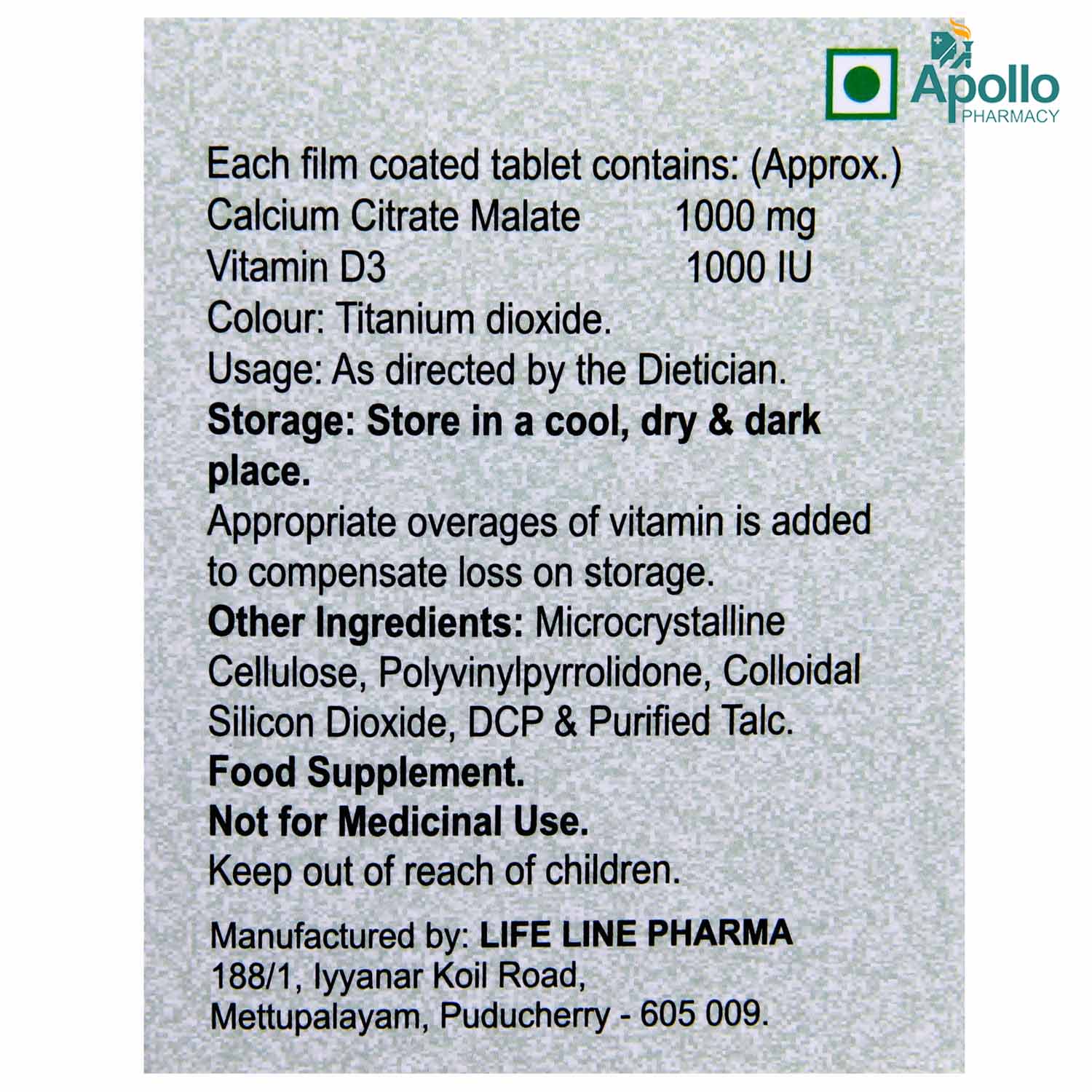
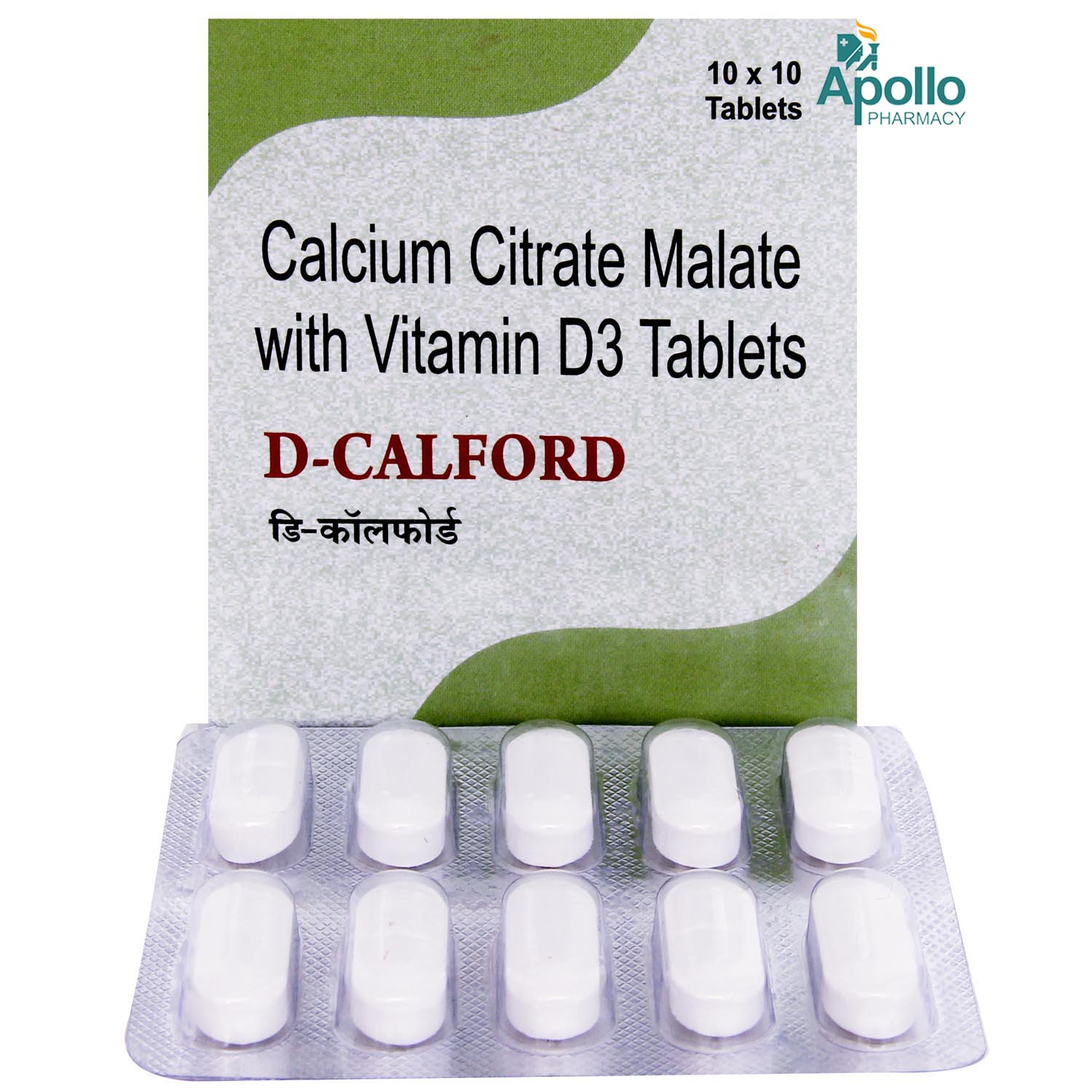
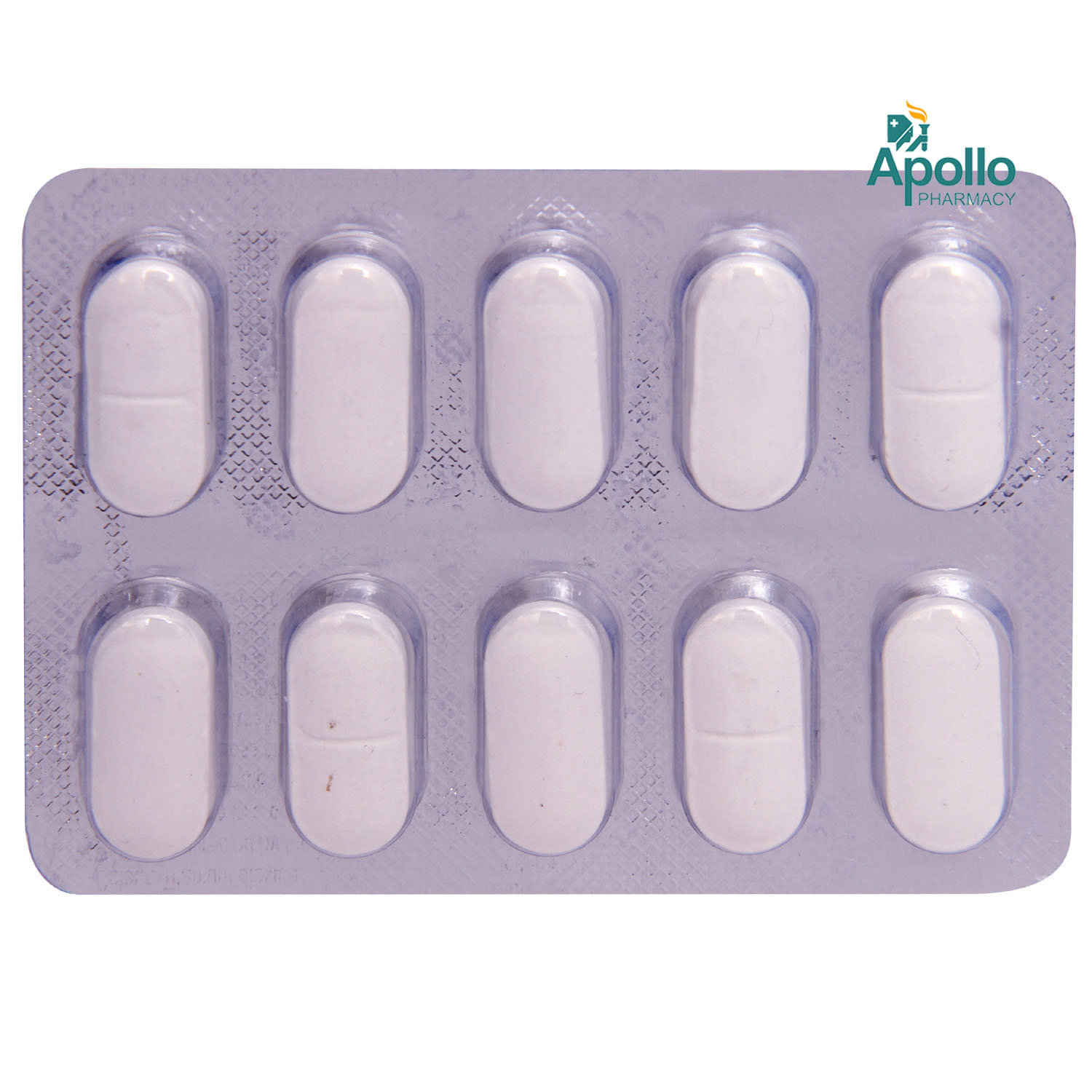
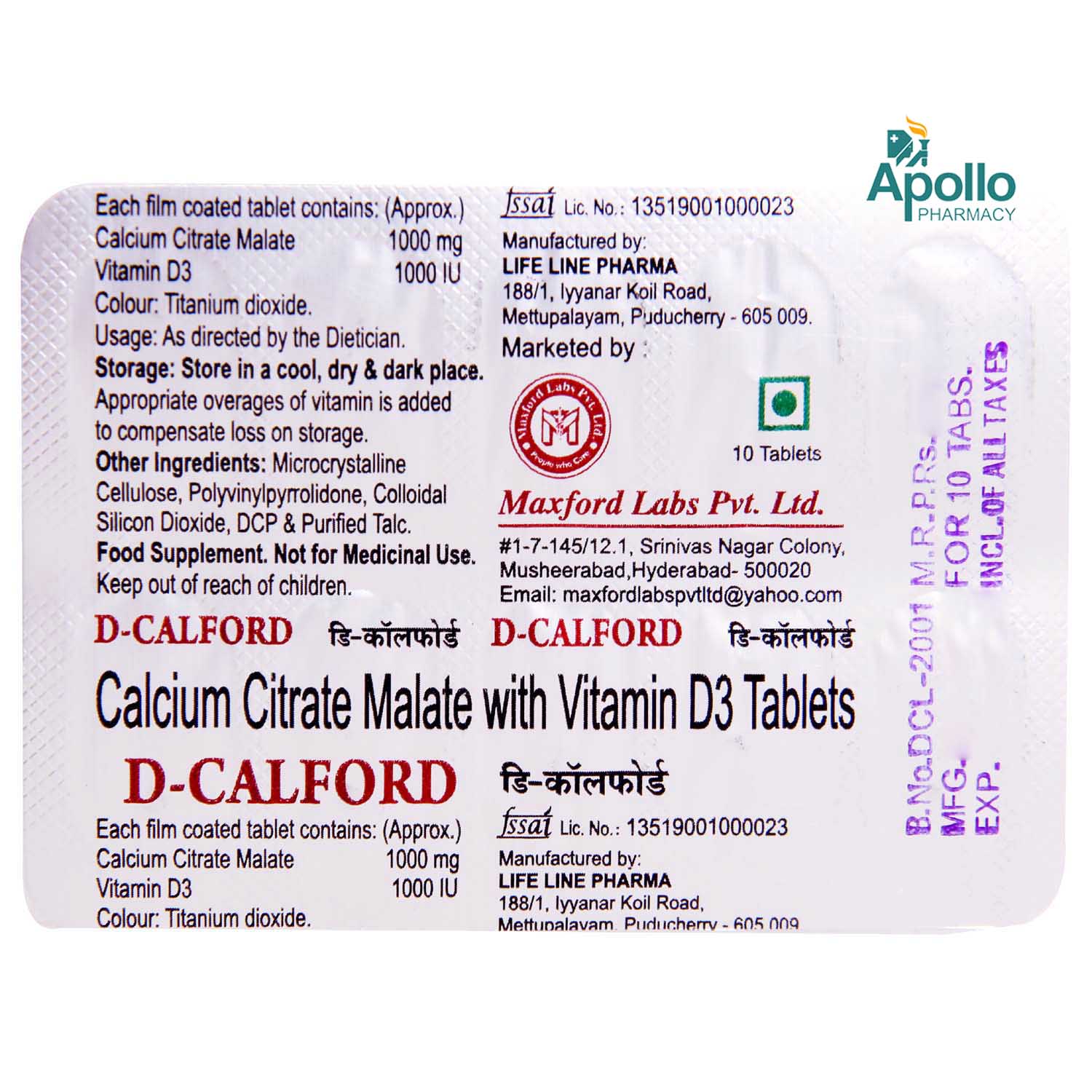





MRP ₹59
(Inclusive of all Taxes)
₹8.8 Cashback (15%)
About D Calford Tablet
D Calford Tablet belongs to the class of nutritional supplements used to prevent or treat low blood calcium levels in people who cannot get sufficient calcium from their diets. D Calford Tablet effectively treats various conditions caused by low calcium levels in the body, such as osteoporosis (weak and brittle bones), osteomalacia/rickets (weak bones), hypoparathyroidism (low levels of parathyroid hormone), and latent tetany (a muscle disease with low blood calcium levels).
D Calford Tablet is a combination of two drugs: Calcium citrate malate (calcium supplement) and Cholecalciferol (vitamin D3). Calcium citrate malate is used to prevent or treat a calcium deficiency. It provides essential nutrients to maintain bone formation. Cholecalciferol helps the body to absorb calcium and phosphorous. Thereby, it increases calcium levels in the blood and helps to build and maintain strong bones.
Take D Calford Tablet as advised by your doctor. In some cases, you may experience stomach upset or constipation. Most of these side effects of D Calford Tablet do not require medical attention and gradually resolve over time. However, if the side effects persist or worsen, please consult your doctor.
If you are allergic to D Calford Tablet , vitamin D products, or other medicines, please tell your doctor. If you are pregnant or breastfeeding, consult a doctor before using D Calford Tablet . D Calford Tablet should be used with caution in children. If you have high calcium or vitamin D levels in blood, liver, kidney or heart problems, inform your doctor before taking D Calford Tablet . Regular tests are recommended while taking D Calford Tablet to monitor calcium levels.
Country of origin
Manufacturer/Marketer address
Online payment accepted

secured payment

india's most trusted pharmacy

genuine products
Manufacturer/Marketer :
Consume Type :
Return Policy :
Expires on or after :
Available Offers
Provide Delivery Location
About D Calford Tablet
D Calford Tablet belongs to the class of nutritional supplements used to prevent or treat low blood calcium levels in people who cannot get sufficient calcium from their diets. D Calford Tablet effectively treats various conditions caused by low calcium levels in the body, such as osteoporosis (weak and brittle bones), osteomalacia/rickets (weak bones), hypoparathyroidism (low levels of parathyroid hormone), and latent tetany (a muscle disease with low blood calcium levels).
D Calford Tablet is a combination of two drugs: Calcium citrate malate (calcium supplement) and Cholecalciferol (vitamin D3). Calcium citrate malate is used to prevent or treat a calcium deficiency. It provides essential nutrients to maintain bone formation. Cholecalciferol helps the body to absorb calcium and phosphorous. Thereby, it increases calcium levels in the blood and helps to build and maintain strong bones.
Take D Calford Tablet as advised by your doctor. In some cases, you may experience stomach upset or constipation. Most of these side effects of D Calford Tablet do not require medical attention and gradually resolve over time. However, if the side effects persist or worsen, please consult your doctor.
If you are allergic to D Calford Tablet , vitamin D products, or other medicines, please tell your doctor. If you are pregnant or breastfeeding, consult a doctor before using D Calford Tablet . D Calford Tablet should be used with caution in children. If you have high calcium or vitamin D levels in blood, liver, kidney or heart problems, inform your doctor before taking D Calford Tablet . Regular tests are recommended while taking D Calford Tablet to monitor calcium levels.
Uses of D Calford Tablet
Medicinal Benefits
D Calford Tablet contains Calcium citrate malate and Cholecalciferol. Calcium citrate malate is a calcium supplement used to prevent or treat a calcium deficiency. It provides essential nutrients to maintain bone formation. Cholecalciferol is vitamin D3 that helps the body to absorb calcium and phosphorous. Thereby, it increases calcium levels in the blood and helps to build and maintain strong bones.
Directions for Use
Storage
Side Effects of D Calford Tablet
- Constipation
- Stomach upset
Drug Warnings
If you are allergic to D Calford Tablet , vitamin D products, or other medicines, please tell your doctor. If you are pregnant or breastfeeding, consult a doctor before using D Calford Tablet . D Calford Tablet should be used with caution in children. If you have high calcium or vitamin D levels in blood, liver, kidney, or heart problems, inform your doctor before taking D Calford Tablet . Regular tests are recommended while taking D Calford Tablet to monitor calcium levels.
Drug Interactions
Drug-Drug Interaction: D Calford Tablet may have interaction with antibiotics (doxycycline, minocycline, ciprofloxacin, levofloxacin), drugs used to treat bone loss (alendronate), anti-cancer drug (estramustine), thyroid drugs (levothyroxine), high cholesterol-lowering medicines (cholestyramine, colestipol), weight-loss drugs (orlistat).
Drug-Food Interaction: No interactions found.
Drug-Disease Interaction: If you have kidney stones, high levels of calcium or vitamin D in the blood, malabsorption syndrome, sarcoidosis (growth of tiny collections of inflammatory cells in any part of the body), Crohn's disease, Whipple's disease (a bacterial infection that most often affects joints and digestive system), achlorhydria (absence of stomach acid), liver, kidney or heart problems, inform your doctor before taking D Calford Tablet .
Drug-Drug Interactions Checker List
- DOXYCYCLINE
- MINOCYCLINE
- CIPROFLOXACIN
- LEVOFLOXACIN
- ALENDRONATE SODIUM
- ESTRAMUSTINE
- LEVOTHYROXINE
- CHOLESTYRAMINE
- COLESTIPOL
- ORLISTAT
Habit Forming
Diet & Lifestyle Advise
- Include dairy products like milk, yogurt, cheese, or milk-based custard in your diet.
- Eat daily a serving of broccoli, cabbage, bok choy (Chinese white cabbage), spinach, and other green leafy vegetables.
- Snack on calcium-rich nuts like Brazil nuts or almonds.
- Sprinkle sesame seeds over your food, vegetables, and salads. Sesame seeds are high in calcium.
- Avoid or reduce the intake of caffeine, soft drinks, and alcohol that inhibit calcium absorption.
- Replace the meat with tofu or tempeh for extra calcium in your food.
Special Advise
- Your doctor may advise regular monitoring of your calcium and Vitamin-D levels.
Disease/Condition Glossary
Osteoporosis: It is a bone disease that weakens and brittle bones by decreasing bone density. As the density of bones decreases, they weaken and are more likely to break. Breaking a bone is a serious complication of osteoporosis, especially in older patients. Women are much more likely to develop osteoporosis than are men. Signs and symptoms include back pain caused by a fractured or collapsed vertebra, loss of height over time, a stooped posture, a bone that breaks much more easily than expected.
Osteomalacia/Rickets: Rickets is a bone disease caused by softening and weakening bones in children due to inadequate vitamin D. Adults can experience a similar condition known as osteomalacia. It causes bone pain, poor growth, and weak bones that can lead to bone deformities.
Tetany: A disease condition due to low calcium levels (hypocalcemia) in the body, which causes cramps and spasms in the hands, feet, and larynx (voice box).
Hypoparathyroidism: It is a disease characterized by low levels of parathyroid hormone. This can cause low calcium levels and trigger tetany.
FAQs
D Calford Tablet contains Calcium citrate malate and Cholecalciferol. Calcium citrate malate is a calcium supplement used to prevent or treat a calcium deficiency. It provides essential nutrients to maintain bone formation. Cholecalciferol is vitamin D3 that helps the body to absorb calcium and phosphorous. Thereby, it increases calcium levels in the blood and helps to build and maintain strong bones.
You are not recommended to take D Calford Tablet if you have hypervitaminosis D (high vitamin D levels in the blood) as it may worsen the condition. However, please consult a doctor before using D Calford Tablet .
D Calford Tablet is not recommended for patients with malabsorption (inefficient absorption of nutrients from the bowel) syndrome. Please consult a doctor before using D Calford Tablet if you have malabsorption syndrome.
You are not recommended to take D Calford Tablet with levothyroxine as co-administration of these two medicines at the same time may reduce the effectiveness of levothyroxine. However, if you are supposed to take both medicines, you are advised to maintain a time gap of a minimum of 4 hours between taking D Calford Tablet and levothyroxine.
D Calford Tablet is not recommended for a patient suffering from kidney stones as it may worsen the condition. Therefore, if you have any kidney problems or have a history of kidney stones, please inform your doctor before taking D Calford Tablet .
Disclaimer
Customers Also Bought
Product Substitutes
Alcohol
Caution
The interaction of alcohol with D Calford Tablet is unknown. Please consult a doctor before consuming alcohol with D Calford Tablet .
Pregnancy
Caution
Please consult a doctor if you are pregnant. D Calford Tablet is given to pregnant women if the doctor thinks the benefits outweigh the risks.
Breast Feeding
Caution
It is unknown whether D Calford Tablet is excreted in human milk. Therefore, please consult a doctor if you are breastfeeding.
Driving
Not applicable
D Calford Tablet usually does not affect your ability to drive or operate machinery.
Liver
Caution
Take D Calford Tablet with caution, especially if you have a history of Liver diseases/conditions. The dose may be adjusted by your doctor as required.
Kidney
Caution
Take D Calford Tablet with caution, especially if you have a history of Kidney diseases/conditions. The dose may be adjusted by your doctor as required.
Children
Caution
D Calford Tablet should be used in children only if recommended by a doctor.
Author Details
We provide you with authentic, trustworthy and relevant information
Uses of D Calford Tablet
Medicinal Benefits
D Calford Tablet contains Calcium citrate malate and Cholecalciferol. Calcium citrate malate is a calcium supplement used to prevent or treat a calcium deficiency. It provides essential nutrients to maintain bone formation. Cholecalciferol is vitamin D3 that helps the body to absorb calcium and phosphorous. Thereby, it increases calcium levels in the blood and helps to build and maintain strong bones.
- Inform your doctor about your constipation symptoms. They may adjust your medication or advise alternative treatments.
- Stay hydrated by drinking sufficient of water (at least 8-10 glasses a day) to help soften stool and promote bowel movements.
- Increase fibre intake by eating foods high in fibre, such as fruits, whole grains, vegetables and legumes, to help bulk up the stool.
- Establish a bowel routine by trying to go to the bathroom at the same time each day to train your bowels.
- Engaging in regular exercise, like walking or yoga, can support in bowel movement stimulation.
- Consult your doctor if constipation persists, and discuss alternative treatments or adjustments to your medication.
Directions for Use
Storage
Drug Warnings
If you are allergic to D Calford Tablet , vitamin D products, or other medicines, please tell your doctor. If you are pregnant or breastfeeding, consult a doctor before using D Calford Tablet . D Calford Tablet should be used with caution in children. If you have high calcium or vitamin D levels in blood, liver, kidney, or heart problems, inform your doctor before taking D Calford Tablet . Regular tests are recommended while taking D Calford Tablet to monitor calcium levels.
Therapeutic Class
Drug-Drug Interactions
Drug-Drug Interactions
Login/Sign Up
The combined use of aluminum hydroxide with D Calford Tablet may increase the risk of toxicity.
How to manage the interaction:
Co-administration of D Calford Tablet with Aluminium hydroxide can possibly result in an interaction, but it can be taken if your doctor has advised it. If you're having any of these symptoms like bone pain, muscle weakness, anemia, seizures, or dementia, it's important to contact your doctor right away. Do not stop using any medications without a doctor's advice.
The combined use of calcifediol with cholecalciferol can increase the risk of side effects.
How to manage the interaction:
Although there is a possible interaction between D Calford Tablet and calcifediol, you can take these medicines together if prescribed by your doctor. If you notice any of these symptoms - irregular heartbeat, seizures, weakness, tiredness, headache, dizziness, ringing in the ears, loss of appetite, feeling sick, dry mouth, strange taste in your mouth, muscle or bone pain, thirst, losing weight, eye infection, sensitivity to light, runny nose or itching - contact a doctor right away. Do not discontinue any medications without consulting a doctor.
Cholecalciferol and doxercalciferol are forms of vitamin D, and taking too much vitamin D may lead to toxic effects.
How to manage the interaction:
Although there is a possible interaction between D Calford Tablet and doxercalciferol, you can take these medicines together if prescribed by your doctor. If you notice any of these symptoms - irregular heartbeat, seizures, weakness, tiredness, headache, dizziness, ringing in the ears, loss of appetite, feeling sick, dry mouth, strange taste in your mouth, muscle or bone pain, thirst, losing weight, eye infection, sensitivity to light, runny nose or itching - make sure to call a doctor right away. Do not discontinue any medications without consulting a doctor.
Co-administration of Cholecalciferol and Calcitriol are forms of vitamin D, and taking too much vitamin D may lead to toxic effects.
How to manage the interaction:
Although there is a possible interaction between D Calford Tablet and calcitriol, you can take these medicines together if prescribed by your doctor. If you notice any of these symptoms - irregular heartbeat, seizures, weakness, tiredness, headache, dizziness, ringing in the ears, loss of appetite, feeling sick, dry mouth, strange taste in your mouth, muscle or bone pain, thirst, losing weight, eye infection, sensitivity to light, runny nose or itching - contact a doctor right away. Do not discontinue any medications without consulting a doctor.
The combined use of cholecalciferol and paricalcitol are forms of vitamin D, and taking too much vitamin D may lead to toxic effects.
How to manage the interaction:
Although there is a possible interaction between D Calford Tablet and paricalcitol, you can take these medicines together if prescribed by your doctor. If you notice any of these symptoms - irregular heartbeat, seizures, weakness, tiredness, headache, dizziness, ringing in the ears, loss of appetite, feeling sick, dry mouth, strange taste in your mouth, muscle or bone pain, thirst, losing weight, eye infection, sensitivity to light, runny nose or itching - contact a doctor right away. Do not discontinue any medications without consulting a doctor.
The combined use of cholecalciferol and ergocalciferol are forms of vitamin D, and taking too much vitamin D may lead to toxic effects.
How to manage the interaction:
Although there is a possible interaction between D Calford Tablet and ergocalciferol, you can take these medicines together if prescribed by your doctor. If you notice any of these symptoms - irregular heartbeat, seizures, weakness, tiredness, headache, dizziness, ringing in the ears, loss of appetite, feeling sick, dry mouth, strange taste in your mouth, muscle or bone pain, thirst, losing weight, eye infection, sensitivity to light, runny nose or itching - contact a doctor right away. Do not discontinue any medications without consulting a doctor.
Taking Cholecalciferol together with Sucralfate may increase the risk or severity of kidney problems.
How to manage the interaction:
There may be a possibility of interaction between Cholecalciferol and Sucralfate, but it can be taken if prescribed by a doctor. Do not discontinue any medications without consulting a doctor.
Cholecalciferol and dihydrotachysterol are forms of vitamin D, and taking too much vitamin D may lead to toxic effects.
How to manage the interaction:
Although there is a possible interaction between D Calford Tablet and dihydrotachysterol, you can take these medicines together if prescribed by your doctor. If you notice any of these symptoms - irregular heartbeat, seizures, weakness, tiredness, headache, dizziness, ringing in the ears, loss of appetite, feeling sick, dry mouth, strange taste in your mouth, muscle or bone pain, thirst, losing weight, eye infection, sensitivity to light, runny nose or itching - contact a doctor right away. Do not discontinue any medications without consulting a doctor.
Co-administration of D Calford Tablet with Dihydroxyaluminum sodium carbonate may increase the effects of Dihydroxyaluminum sodium carbonate, which could result in too high aluminum blood levels.
How to manage the interaction:
Although there is an interaction, D Calford Tablet can be used with Dihydroxyaluminum sodium carbonate if prescribed by the doctor. However, maintain a gap of 2-3 hours between both medicines. Do not discontinue the medication without consulting a doctor.
Co-administration of Dolutegravir with D Calford Tablet can reduce the effectiveness of dolutegravir.
How to manage the interaction:
Although there is an interaction, D Calford Tablet can be used with Dolutegravir if prescribed by the doctor. However, take dolutegravir at least two hours before or six hours after D Calford Tablet. Do not discontinue the medication without consulting a doctor.
Drug-Drug Interactions Checker List
- DOXYCYCLINE
- MINOCYCLINE
- CIPROFLOXACIN
- LEVOFLOXACIN
- ALENDRONATE SODIUM
- ESTRAMUSTINE
- LEVOTHYROXINE
- CHOLESTYRAMINE
- COLESTIPOL
- ORLISTAT
Diet & Lifestyle Advise
- Include dairy products like milk, yogurt, cheese, or milk-based custard in your diet.
- Eat daily a serving of broccoli, cabbage, bok choy (Chinese white cabbage), spinach, and other green leafy vegetables.
- Snack on calcium-rich nuts like Brazil nuts or almonds.
- Sprinkle sesame seeds over your food, vegetables, and salads. Sesame seeds are high in calcium.
- Avoid or reduce the intake of caffeine, soft drinks, and alcohol that inhibit calcium absorption.
- Replace the meat with tofu or tempeh for extra calcium in your food.
Habit Forming
Side Effects of D Calford Tablet
- Constipation
- Stomach upset
Special Advise
- Your doctor may advise regular monitoring of your calcium and Vitamin-D levels.
Disease/Condition Glossary
Osteoporosis: It is a bone disease that weakens and brittle bones by decreasing bone density. As the density of bones decreases, they weaken and are more likely to break. Breaking a bone is a serious complication of osteoporosis, especially in older patients. Women are much more likely to develop osteoporosis than are men. Signs and symptoms include back pain caused by a fractured or collapsed vertebra, loss of height over time, a stooped posture, a bone that breaks much more easily than expected.
Osteomalacia/Rickets: Rickets is a bone disease caused by softening and weakening bones in children due to inadequate vitamin D. Adults can experience a similar condition known as osteomalacia. It causes bone pain, poor growth, and weak bones that can lead to bone deformities.
Tetany: A disease condition due to low calcium levels (hypocalcemia) in the body, which causes cramps and spasms in the hands, feet, and larynx (voice box).
Hypoparathyroidism: It is a disease characterized by low levels of parathyroid hormone. This can cause low calcium levels and trigger tetany.
All Substitutes & Brand Comparisons
RX
ND-K2 Tablet 10's
Nddm Pharmaceuticals
₹140.5
(₹12.65 per unit)
138% COSTLIER

Have a query?
Buy best Health & Nutrition products by
Others
AYUR
HIMALAYAN ORGANICS
WELLBEING NUTRITION
HEALTHVIT
APOLLO LIFE
HORLICKS
PURE NUTRITION
GNC
HAPPILO
KELLOGG S
APOLLO PHARMACY
ENSURE
Optimum Nutrition
SWISSE
Dabur
FAST&UP
ZANDU
MUSCLEBLAZE
Muscletech
SUGAR FREE
COMPLAN
KAPIVA
PROHANCE
QNT
Pediasure
THE VITAMIN COMPANY
VOGUE WELLNESS
CENTRUM
CUREVEDA
GLUCON-D
PROTINEX
BAIDYANATH
Millet Marvels
OZIVA
LION
ORIGIN
PENTASURE
RITEBITE
THE GOOD BUG
AYUSH KALP
RASAYANAM
MANNA
TRUE ELEMENTS
BOURNVITA
EQUAL
HIMALAYA
MY FITNESS
CALCIMAX
PATANJALI
SWADESHI
TONG GARDEN
BEAUTYWISE
ISOPURE
HEALTHYR-U
NESTLE RESOURCE
SAFFOLA
YOGABAR
B-PROTIN
BODYWELL
PINTOLA
Power Gummies
ULTRA D3
FITSPIRE
GALACT
GRD
INDIA HEMP ORGANICS
JIVA
NEUHERBS
NUTRASWISS
INJA
Performance Inspired
REVITAL
THREPTIN
Bolas
CELEVIDA
ENERZAL
ESSENTIAL
IN YOU
ORGANIC INDIA
PRO-PL
QUAKER
WEST COAST
BOOST
D-PROTIN
ENDURA MASS
ESPERER
FRESUBIN
GOFIGURE
HEALTHKART
OURDAILY
PROLYTE
SRI SRI TATTVA
VIVAMOM
Amocare
BAIDYANATH VANSAAR
BASIC AYURVEDA
BLACKMORES
BOLD CARE
ECOPROT
Vlado Sky Enterprise Pvt Ltd
Abbott India Ltd
Sun Pharmaceutical Industries Ltd
Apollo Healthco Limited
Zydus Healthcare Ltd
Macleods Pharmaceuticals Ltd
West Coast Pharmaceuticals Pvt Ltd
Intas Pharmaceuticals Ltd
Mankind Pharma Pvt Ltd
Meyer Organics Pvt Ltd
Emcure Pharmaceuticals Ltd
Lupin Ltd
Alkem Laboratories Ltd
Nutritionalab Pvt Ltd
Eris Life Sciences Ltd
Akumentis Healthcare Ltd
British Biologicals
La Renon Healthcare Pvt Ltd
Cipla Ltd
Micro Labs Ltd
Zuventus Healthcare Ltd
Torrent Pharmaceuticals Ltd
Pharmed Ltd
Dr Reddy's Laboratories Ltd
Modi Mundipharma Pvt Ltd
Corona Remedies Pvt Ltd
Hindustan Unilever Ltd
Indchemie Health Specialities Pvt Ltd
Apex Laboratories Pvt Ltd
Koye Pharmaceuticals Pvt Ltd
Leeford Healthcare Ltd
Bioceutics Inc
East West Pharma India Pvt Ltd
Alniche Life Sciences Pvt Ltd
FDC Ltd
Alembic Pharmaceuticals Ltd
Aristo Pharmaceuticals Pvt Ltd
DR Johns Lab Pharma Pvt Ltd
Herbs Nutriproducts Pvt Ltd
Guardian Healthcare Services Pvt Ltd
Vasu Organics Pvt Ltd
Pulse Pharmaceuticals
Fourrts India Laboratories Pvt Ltd
TTK Healthcare Ltd
Raptakos Brett & Co Ltd
USV Pvt Ltd
Glanbia Performance Nutrition India Pvt Ltd
Morepen Laboratories Ltd
Innovcare Life Sciences Pvt Ltd
Linux Laboratories Pvt Ltd
Troikaa Pharmaceuticals Ltd
Cadila Pharmaceuticals Ltd
Bright Lifecare Pvt Ltd
Wockhardt Ltd
Sanofi India Ltd
Primus Remedies Pvt Ltd
Zydus Cadila
Kellogg India Pvt Ltd
Tablets India Ltd
Indoco Remedies Ltd
Medley Pharmaceuticals Ltd
Overseas Health Care Pvt Ltd
Procter & Gamble Health Ltd
Shri Balaji Overseas
Dabur India Ltd
Ordain Health Care Global Pvt Ltd
Systopic Laboratories Pvt Ltd
Ajanta Pharma Ltd
Daris Biocare
Health & Happiness (H&H) Trading India Pvt Ltd
Hexagon Nutrition Pvt Ltd
Nutricia International Pvt Ltd
Zee Laboratories Ltd
Aareen Healthcare Pvt Ltd
Aeronutrix Sports Products Pvt Ltd
Emami Ltd
Radicool Pharmaceuticals Pvt Ltd
Wanbury Ltd
Biovitamins Pvt Ltd
Cadila Healthcare Ltd
Esmatrix Life Sciences Pvt Ltd
Ipca Laboratories Ltd
Klm Laboratories Pvt Ltd
Lloyd Healthcare Pvt Ltd
Sain Medicaments Pvt Ltd
Septalyst Lifesciences Pvt Ltd
Tas Med India Pvt Ltd
Wallace Pharmaceuticals Pvt Ltd
Biorex Healthcare Pvt Ltd
Elbrit Life Sciences Pvt Ltd
Levin Life Sciences Pvt Ltd
Panacea Biotec Ltd
Adret Retail Pvt Ltd
Cipla Health Ltd
Delcure Life Sciences Ltd
Femura Pharmaceuticals Pvt Ltd
Gladstone Pharma India Pvt Ltd
GlaxoSmithKline Consumer Healthcare Ltd
Kepler Healthcare Pvt Ltd
Ronyd Healthcare Pvt Ltd
SPECIALITY SUPPLEMENT
CALCIUM
IRON
VITAMIN D
COLLAGEN
VITAMIN B12
VITAMIN C
FISH OIL OMEGA
VITAMIN B
MULTIVITAMIN
Adult Nutrition Drink
ZINC
SEXUAL HEALTH SUPPLEMENT
WHEY PROTEIN
Kids Nutrition Drink
VITAMIN B9
ENERGY DRINK
SPECIALITY NUTRITION DRINK
DRY FRUIT
HERBAL JUICE
VITAMIN E
Prebiotic & Probiotic
ORS
SUGAR SUBSTITUTE
WOMEN & MOTHER NUTRITION DRINK
Chyawanprash
MAGNESIUM
Protein Bar
BREAKFAST CEREAL
Protein Powder
BIOTIN
DIABETIC NUTRITION DRINK
Honey
WEIGHT LOSS
Fat Burner
PLANT PROTEIN POWDER
VITAMIN B1
Apple Cider Vinegar
MELATONIN
APPETITE STIMULANT
Meal Replacement
Peanut Butter
AMINO ACID
Flax seed Oil
INFUSION TEA
NUT & SEED
Ashwagandha
Instant Food
OATS
Olive Oil
Mass Gainer
Pre Workout
CURCUMIN
POTASSIUM
VITAMIN A
DISKETTE
L-Carnitine
Cod Liver Oil
CREATINE
MILLETS & CEREALS
VITAMIN B6
ARGININE
COENZYME Q10
Shilajit
Appetite Suppressant
Chromium
MILK THISTLE
Glutathione
VITAMIN B2
VITAMIN K
L-Glutamine
MORINGA
GARCINIA CAMBOGIA
GREEN TEA
SPIRULINA
ALPHA-LIPOIC ACID
GLUCOSAMINE
GOKSHURA
BCAA Protein Powder
GILOY
NEEM
SAFFRON
SELENIUM
TRIPHALA
Tulsi
VITAMIN B3
VITAMIN B5
Brahmi
CANDIES
FRUIT JUICE
Face Gel
Specialty Supplements
WEIGHT GAINER
WHEAT GRASS POWDER









